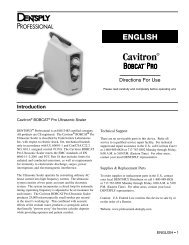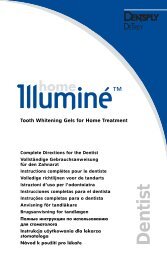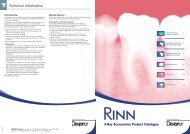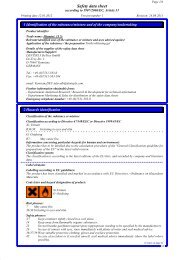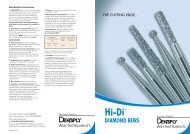Long-term release of monomers from modern dental ... - Dentsply
Long-term release of monomers from modern dental ... - Dentsply
Long-term release of monomers from modern dental ... - Dentsply
Create successful ePaper yourself
Turn your PDF publications into a flip-book with our unique Google optimized e-Paper software.
Monomer <strong>release</strong> <strong>from</strong> composite materials 69<br />
In various studies (4, 9) the degree <strong>of</strong> monomer–<br />
polymer conversion in <strong>dental</strong>-composite resins has been<br />
found to vary between approximately 35 and 77%.<br />
Several authors investigated a possible correlation<br />
between the degree <strong>of</strong> conversion <strong>from</strong> the monomer to<br />
polymer which de<strong>term</strong>ine the chemical stability and<br />
solubility. Pearson & <strong>Long</strong>man (10) showed that<br />
reduced irradiation significantly increases the solubility.<br />
Tanaka et al. (1) found that increasing the irradiation<br />
time <strong>from</strong> 30 to 50 s resulted in a significant decrease in<br />
residual monomer contents and the quantities that were<br />
<strong>release</strong>d into water. In contrast to the above studies,<br />
Ferracane (4) found a very poor correlation between<br />
the degree <strong>of</strong> conversion and solubility.<br />
The elution <strong>of</strong> substances <strong>from</strong> composite materials<br />
has been widely studied (11–15). Geurtsen et al. (13)<br />
evaluated the <strong>release</strong> <strong>of</strong> substances <strong>from</strong> restorative<br />
materials and also the cytotoxicity <strong>of</strong> the <strong>release</strong>d<br />
<strong>monomers</strong> on fibroblasts. In their study, substances were<br />
identified that caused severe or minor cytotoxic effects in<br />
all permanent and primary cell lines. Additionally, their<br />
results indicate that for most <strong>of</strong> the severely toxic composite<br />
components, few cytotoxic alternatives are available.<br />
Spahl et al. (16) identified (co)<strong>monomers</strong>,<br />
additives, and contaminants <strong>from</strong> the manufacturing<br />
process to be <strong>release</strong>d <strong>from</strong> resin composites. Several<br />
in vitro studies (12, 17) have shown the cytotoxic, genotoxic,<br />
mutagenic or estrogenic effects and pulpal and<br />
gingival/oral mucosa reactions <strong>of</strong> some <strong>of</strong> the <strong>monomers</strong><br />
<strong>release</strong>d <strong>from</strong> the composite materials. However, most <strong>of</strong><br />
the in vitro studies (14, 18) have used experimental<br />
composite materials to investigate the process <strong>of</strong> monomer<br />
elution, leading to useful information about commercial<br />
products.<br />
Several studies have been conducted in water and in<br />
oral/food-simulating liquids, among which 75% ethanol/water<br />
solution has been used. This solution is<br />
recommended by the Food and Drug Administration<br />
(FDA) Guidelines <strong>of</strong> the USA (1976, 1988) as a food<br />
simulator and might be considered clinically relevant<br />
(19). It simulates the influence <strong>of</strong> certain beverages<br />
(including alcoholic), vegetables, fruits, and syrup.<br />
Different studies (9, 12) indicate the important role <strong>of</strong><br />
the type <strong>of</strong> the solvent, and that irreversible processes,<br />
such as leaching <strong>of</strong> components, may occur (e.g. in the<br />
presence <strong>of</strong> ethanol). A close match in the solubility<br />
parameter results in maximum s<strong>of</strong>tening <strong>of</strong> the resin<br />
(20, 21). This phenomenon may contribute to irreversible<br />
material degradation provoked by ethanol because<br />
it penetrates the matrix and expands the space between<br />
polymer chains into which soluble substances, such as<br />
unreacted <strong>monomers</strong>, may diffuse. A 75% ethanol<br />
solution has a solubility parameter which matches that<br />
<strong>of</strong> BisGMA (20, 21).<br />
Another point <strong>of</strong> concern about the elution process <strong>of</strong><br />
<strong>monomers</strong> <strong>of</strong> the resin composites is the method used to<br />
de<strong>term</strong>ine the quality and the quantity <strong>of</strong> the eluted<br />
<strong>monomers</strong>. Analysis is usually performed with highperformance<br />
liquid chromatography (HPLC) (14, 22). In<br />
this case, pure components are used as external standards<br />
for the identification and quantification <strong>of</strong> the<br />
eluted components. However, as reported previously<br />
(12), this method has some disadvantages and it is not<br />
suitable to give an exact identification <strong>of</strong> the substances<br />
eluted. Liquid chromatography–mass spectrometry<br />
(LC–MS) is an analytical technique that combines the<br />
advantages <strong>of</strong> an LC instrument with those <strong>of</strong> a mass<br />
spectrometer. High-performance liquid chromatography<br />
is a means <strong>of</strong> separating components <strong>of</strong> mixtures by<br />
passing them through a chromatographic column so that<br />
they emerge sequentially. Because LC operates in the<br />
liquid phase but MS is a gas-phase method, it is not a<br />
simple matter to connect the two. In order to allow the<br />
separated components <strong>of</strong> a mixture to be passed<br />
sequentially <strong>from</strong> the LC into the MS, an interface is<br />
needed. Having interfaced the two, LC–MS is a very<br />
powerful technique (23). A combination <strong>of</strong> HPLC (or<br />
LC) with MS can be used in these cases for a very specific<br />
identification <strong>of</strong> the compounds eluted (15). The fact that<br />
most <strong>of</strong> the studies made in this field were performed<br />
without LC–MS highlights the need for further research<br />
in this field.<br />
Although the advantages <strong>of</strong> the light-cured composites<br />
cannot be questioned, the chemically cured composites<br />
still have important applications in contemporary<br />
restorative dentistry, especially in areas that are not<br />
easily penetrable by light (24). This low conversion rate<br />
(17–24) <strong>of</strong> these materials could result in an increased<br />
<strong>release</strong> <strong>of</strong> <strong>monomers</strong>. Core build-up materials may be in<br />
contact with the oral cavity for a long period <strong>of</strong> time<br />
before crown preparation is performed. No information<br />
on the elution <strong>of</strong> <strong>monomers</strong> <strong>from</strong> core build-up materials<br />
exists in the literature.<br />
Although much literature has been published on the<br />
<strong>release</strong> <strong>of</strong> <strong>monomers</strong> (3, 11–13, 15, 25), information is<br />
still lacking with respect to the elution <strong>of</strong> <strong>monomers</strong><br />
<strong>from</strong> <strong>modern</strong> composite materials such as ormocers,<br />
nanohybrid composite resins, and core build-up materials<br />
that are used daily in the <strong>dental</strong> clinical practice.<br />
Therefore, new studies are necessary to evaluate these<br />
materials under clinically relevant conditions. Additionally,<br />
no information is available on the <strong>release</strong> <strong>of</strong><br />
<strong>monomers</strong> over a post-cure period <strong>of</strong> longer than<br />
3 months. A longer storage time period simulating clinical<br />
oral conditions would be very useful in order to<br />
evaluate the composite materials. However, to correspond<br />
to the period that the composite restorations are<br />
expected to remain in the mouth, a storage time <strong>of</strong><br />
5–10 yr would be necessary. This would not be particularly<br />
useful for studying composite materials because<br />
each year new composite materials become commercially<br />
available and therefore results concerning 10-yr-old<br />
composite materials would not be clinically relevant.<br />
Therefore, the aim <strong>of</strong> the present in vitro study was to<br />
identify and quantify the elution <strong>of</strong> <strong>monomers</strong> <strong>of</strong> three<br />
different resin composites using liquid chromatography<br />
tandem mass spectrometry (LC–MS/MS), after different<br />
curing times and storage periods up to 1 yr after curing.<br />
Additionally, the following hypothesis was examined:<br />
composite materials with new chemistry, such as ormocers,<br />
<strong>release</strong> fewer <strong>monomers</strong> than materials with traditional<br />
chemistry.



